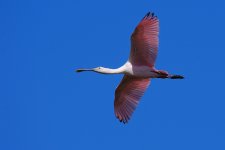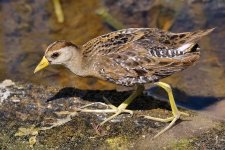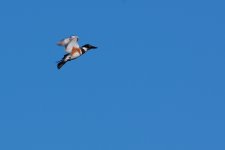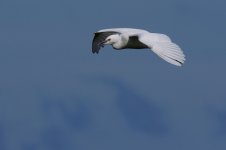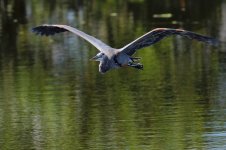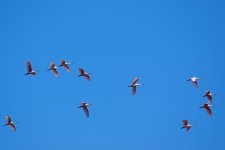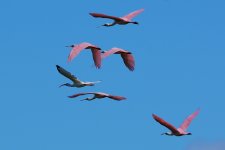hosesbroadbill
Well-known member
Tamron vs 400 5.6
I don't think it is hijacking at all. It is a comparison that I think is relevant to owners of all brands of cameras and probably something that all of us have considered. Prime plus extender or zoom to use while birding.
I also agree that while direct comparisons are not available, it is good to see what results people are getting with different lighting and set ups. Helps with the decision process.
Also agree that at close range a good shot should be had. What I am particularly interested in is how the IS is or is not an advantage. Does the extra weight of the Tamron offset it's IS. Do people have good low light shots with a prime plus extender that show excellent detail at very low shutter speeds? Can you at 560mm plus a crop shoot shots at 1/160th hand held and get no motion blur?
With regards to BIF with the 400 5.6, I do not see how that relates to the comparison. Granted the 400 5.6 is fantastic at BIF. Again, I own it. But if you are out birding and an opportunity arises, it is not as if you will have the time to take the extender off and shoot with just the 400. So it seems to me that either you are walking around with the 400, the 400 + 1.4 or something else like the Tamron. All have their pros and cons.
I have posted some of these before but here are a few shots I have of BIF with the Tamron. All hand held with IS off. And also a shot of a House Finch at 600mm with SS at 1/160th. Taken in heavy cloud cover just before it started to rain.
House Finch
https://www.flickr.com/photos/120553232@N02/15228268118/
A Royal Tern in flight. f6.3
https://www.flickr.com/photos/120553232@N02/15038294892/in/photostream/
A Cormorant in flight
https://www.flickr.com/photos/120553232@N02/14825811917/
A Common Tern in flight
https://www.flickr.com/photos/120553232@N02/14314171468/
A Kestrel that was a heavy crop
https://www.flickr.com/photos/120553232@N02/13694704734/in/photostream/
A Forsters Tern at close range that was moving really fast. Could not have gotten the whole bird without a zoom
https://www.flickr.com/photos/120553232@N02/15110570409/
I think the lens does just fine with BIF. Not saying it is as good and certainly not better than the 400mm, but still it is good. Keep in mind I am a total newb. Only process photos in DPP. Probably takes me 30 seconds to process a photo. I figure that I am better off working on my bushcraft than at processing pics. If I get close to the bird and keep a steady hand then there should be very little to do later on. I only apply basic sharpening to all photos. Change white balance on occasion and perhaps add or take away a little saturation plus some cropping. I leave the noise reduction on auto.
I will go out on the right wind to a local hawkwatch and try and get BIF of small birds as the pass by.
Here's a few more from my 550d and 400/5.6 + 1.4x. I've included a flight shot of a tern taken at about 50m, just to show the performance at medium range.
I do think these comparisons are of limited value, however. They take no account of differences in range, lighting etc. If you get close enough to a bird with either set up, you should get a good shot. As Roy C says, it is easy to cherry pick a few nice shots with either combo.
I don't think it is hijacking at all. It is a comparison that I think is relevant to owners of all brands of cameras and probably something that all of us have considered. Prime plus extender or zoom to use while birding.
I also agree that while direct comparisons are not available, it is good to see what results people are getting with different lighting and set ups. Helps with the decision process.
Also agree that at close range a good shot should be had. What I am particularly interested in is how the IS is or is not an advantage. Does the extra weight of the Tamron offset it's IS. Do people have good low light shots with a prime plus extender that show excellent detail at very low shutter speeds? Can you at 560mm plus a crop shoot shots at 1/160th hand held and get no motion blur?
With regards to BIF with the 400 5.6, I do not see how that relates to the comparison. Granted the 400 5.6 is fantastic at BIF. Again, I own it. But if you are out birding and an opportunity arises, it is not as if you will have the time to take the extender off and shoot with just the 400. So it seems to me that either you are walking around with the 400, the 400 + 1.4 or something else like the Tamron. All have their pros and cons.
I have posted some of these before but here are a few shots I have of BIF with the Tamron. All hand held with IS off. And also a shot of a House Finch at 600mm with SS at 1/160th. Taken in heavy cloud cover just before it started to rain.
House Finch
https://www.flickr.com/photos/120553232@N02/15228268118/
A Royal Tern in flight. f6.3
https://www.flickr.com/photos/120553232@N02/15038294892/in/photostream/
A Cormorant in flight
https://www.flickr.com/photos/120553232@N02/14825811917/
A Common Tern in flight
https://www.flickr.com/photos/120553232@N02/14314171468/
A Kestrel that was a heavy crop
https://www.flickr.com/photos/120553232@N02/13694704734/in/photostream/
A Forsters Tern at close range that was moving really fast. Could not have gotten the whole bird without a zoom
https://www.flickr.com/photos/120553232@N02/15110570409/
I think the lens does just fine with BIF. Not saying it is as good and certainly not better than the 400mm, but still it is good. Keep in mind I am a total newb. Only process photos in DPP. Probably takes me 30 seconds to process a photo. I figure that I am better off working on my bushcraft than at processing pics. If I get close to the bird and keep a steady hand then there should be very little to do later on. I only apply basic sharpening to all photos. Change white balance on occasion and perhaps add or take away a little saturation plus some cropping. I leave the noise reduction on auto.
I will go out on the right wind to a local hawkwatch and try and get BIF of small birds as the pass by.
Last edited:




